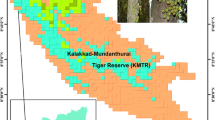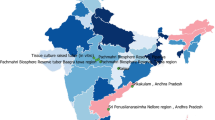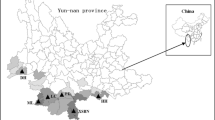Abstract
Dioscorea polystachya Turcz. is the authentic herb Yam in Chinese traditional medicine. In the medicinal marketplace, some related Dioscorea species are mislabeled as “Yams”, such as D. alata L., D. exalata C.T. Ting & M.C. Chang, D. persimili Prain et Burkill, D. fordii Prain et Burkill and D. japonica Thunb. To determine the genetic relationships among these species and develop a rapid and accurate method for D. polystachya identification, Inter Simple Sequence Repeat (ISSR), Intron Sequence Amplified Polymorphism (ISAP), Sequence-Related Amplified Polymorphism (SRAP) and Sequence Characterized Amplified Region (SCAR) markers were used in this study. By combining ISSR, ISAP and SRAP markers, a high degree of variation among the Dioscorea species was detected. Moreover, a relatively high gene flow (Nm = 0.3293) among the species was observed. This may result from gene pool exchanges of wild materials. The phylogenetic tree and genetic similarity analysis showed that D. japonica had the closest genetic relationship with D. polystachya. Considering the lowest inter-species variation observed in D. polystachya and the highest genetic divergence within D. japonica, we suggest a taxonomy of a one-species complex, D. polystachya–D. japonica, for breeding and conservation purposes. The phylogenetic data in this study indicated that D. alata and D. persimilis are independent species, not cultigens. Furthermore, a SCAR marker was developed that could be used to discriminate the authentic herb D. polystachya from other Dioscorea species. Overall, these results are useful as guidelines for breeding programs and conservation actions.





Similar content being viewed by others
References
Adeniran AA, Sonibare MA (2016) Exploitation of petiole, nodal segment, bulbil and tuber anatomy for species identification in Dioscorea Linn species from Oyo and Ekiti states southwestern Nigeria. Nigerian J Natural Prod Med. 20:43
Al-Qurainy F, Al-Ameri AA, Khan S, Nadeem M, Gaafar ARZ, Tarroum M (2018) SCAR marker for gender identification in date palm (Phoenix dactylifera L.) at the seedlzing stage. Int J Genom. 2018:3035406
Araki H, Harada T, Yakuwa T (1983) Some characteristics of interspecific hybrids between Dioscorea japonica Thunb. and Dioscorea opposita Thunb. J Japanese Soci Horticult Sci. 52:153–158
Biswas MK, Xu Q, Deng X (2010) Utility of RAPD, ISSR, IRAP and REMAP markers for the genetic analysis of Citrus spp. Sci Hortic 124:254–261
Devaiah K, Balasubramani SP, Venkatasubramanian P (2011) Development of randomly amplified polymorphic DNA based SCAR marker for identification of Ipomoea mauritiana (Convolvulaceae). Evid-Based Complem Altern Med. 2011:868–720
Foll M, Beaumont MA, Gaggiotti O (2008) An approximate Bayesian computation approach to overcome biases that arise when using amplified fragment length polymorphism markers to study population structure. Genetics 179:927–939
Ghosh M, Chezhian P, Sumathi R, Yasodha R (2010) Development of SCAR marker in Casuarina equisetifolia for species authentication. Trees 25:465–472
Hahn SK (1991) Yams. In: Simmonds, N.W. (Ed) Evolution of crop plants., Longman, London.
Hang YY (1995) Determination of the content of main constituents and pharmacologic experiments on Dioscorea japonica in China. J Plant Res Environ. 5:5–8
Hang YY, Xu LS, Shi DR, Qin HZ, Zhou YF (2007) Morphological features and its taxonomic significance of starch grain in subterranean organ of Dioscorea L. in China. J Plant Res Environ. 15:1–8
Hang YY, Sun XQ (2020) Dioscoreaceae in China, Phoenix Science Press, Nanjing
Hodeba M, Abang M, Robert A (2008) Genomics of Yams, a Common Source of Food and Medicine in the Tropics. In: Moore PH, Ming R(eds.), Genomics of Tropical Crop Plants. 1rd edn.Springer, New York, pp. 549–570
In Board of pharmacopoeia of PR China (2020) Pharmacopoeia of the People’s Republic of China, part I. Board of pharmacopoeia of PR China, Beijing, pp 30
Karnick CR (1969) Dioscorea (YAMS) - the food of the slaves, with potentials for newer drugs: a review. Quart J Crude Drug Res 9:1372–1391
Lalitha S (2000) Primer premier 5. biotech software & internet report. The Comp Softw J for Scient 1:270–272
Lay HL, Liu HJ, Liao MH, Chen CC, Liu S, Sheu BW (2001) Genetic identification of Chinese drug materials in Yams (Dioscorea spp.) by RAPD analysis. J Food Drug Anal 9:132–138
Lebot V, Trilles B, Noyer JL, Modesto J (1998) Genetic relationships between Dioscorea alata L. cultivars. Genet Resour Crop Evol 45:499–509
Li MM, Zhou YF, Guo JL, Sun XQ, Hang YY (2012) Micro-morphological characteristics of leaf epidermis and its taxonomic significance in Dioscorea from China. Acta Botan Boreali-Occiden Sin 11:2232–2242
Liu Y, He B, Cao H (2000) Application of gene technology in quality control of Chinese materia medica II. Identification of Chinese Rhizoma Dioscoreae by DNA sequencing. Chinese Traditional and Herbal Drugs 32:1026–1030
Loko YL, Adjatin A, Dansi A, Vodouhè R, Sanni A (2015) Participatory evaluation of Guinea yam (Dioscorea cayenensis Lam.–D. rotundata Poir. complex) landraces from Benin and agro-morphological characterization of cultivars tolerant to drought, high soil moisture and chips storage insects. Genet Resour Crop Evol 62:1181–1192
Malapa R, Arnau G, Noyer JL, Lebot V (2005) Genetic diversity of the greater Yam (Dioscorea alata L.) and relatedness to D. nummularia Lam. and D. transversa Br. as revealed with AFLP Markers. Genet Resour Crop Evol 52:919–929
Marieschi M, Torelli A, Bianch A, Bruni R (2011) Detecting Satureja montana L. and Origanum majorana L. by means of SCAR–PCR in commercial samples of Mediterranean oregano. Food Control 22:542–548
Martin FW, Rhodes AM (1978) The relationship of Dioscorea cayenensis and D. rotundata. Trop Agric 55:193–206
Mengesha WA, DemissewS FM, Smith R, Nordal I, Wilkin P (2013a) Genetic diversity and population structure of Guinea yams and their wild relatives in South and South West Ethiopia as revealed by microsatellite markers. Genet Resour Crop Evol 60:529–541
Mengesha WA, Demissew S, Fay M, Smith R, Nordal I, Wilkin P (2013b) Genetic diversity and species delimitation in the cultivated and wild Guinea yams (Dioscorea spp.) from Southwest Ethiopia as determined by AFLP (amplified fragment length polymorphism) markers. Genet Resour Crop Evol 60:1365–1375
Mignouna HD, Abang MM, Wanyera NW, Chikaleke VA, Asiedu R, Thottappilly G (2005) PCR marker-based analysis of wild and cultivated Yams (Dioscorea spp.) in Nigeria: genetic relationships and implications for ex situ conservation. Genet Resour Crop Evol 52:755–763
Mizuki I, Ishida K, Tani N, Tsumura Y (2010) Fine-scale spatial structure of genets and sexes in the dioecious plant Dioscorea japonica, which disperses by both bulbils and seeds. Evol Ecol 24:1399–1415
Mukherjee P, Bhat KV (2013) Phylogenetic relationship of wild and cultivated yam species (Dioscorea spp.) of India inferred from PCR–RFLP analysis of two cpDNA loci. Plant Syst Evol 299:1587–1597
Narzary D, Mahar KS, Rana T, Ranade S (2009) Analysis of genetic diversity among wild pomegranates in Western Himalayas, using PCR methods. Sci Hortic 121:237–242
Nascimento WF, Rodrigues JF, Koehler S, Gepts P, Veasey EA (2013) Spatially structured genetic diversity of the Amerindian yam (Dioscorea trifida L.) assessed by SSR and ISSR markers in Southern Brazil. Genet Resour Crop Evol 60:2405–2420
Peakall R, Smouse PE (2012) GenAlEx 6.5: genetic analysis in excel. Population genetic software for teaching and research–an update. Bioinformatics 28:2537–2539
Peng B, Zhang Y, Sun X, Li M, Xue J, Hang YY (2017) Genetic relationship and identification of Dioscorea polystachya cultivars accessed by ISAP and SCAR markers. Arch Biol Sci. 69:277–284
Rohlf F (2000) NTSYS-PC, numerical taxonomy system for the PC ExeterSoftware, Version 2.1. Applied Biostatistics Inc Setauket, USA
Saengprajak J (2012) Genetic diversity and species identification of cultivar species in subtribe cucumerinae (Cucurbitaceae) using RAPD and SCAR markers. Am J Plant Sci 03:1092–1097
Shin KO, Jeon JR, Ji SL, Kim JY, Chu HL, Kim SD, Yu YS, Nam DH (2006) Lactic acid fermentation of Chinese yam (Dioscorea batatas Decne) flour and its pharmacological effect on gastrointestinal function in rat model. Biotechnol Bioprocess Eng 11:240
Shiwachi H, Onjo M, Hayashi M (2000) Classification of yams (Dioscorea spp.) based on morphological characters and RAPD method. Jpn J Tropic Agric 44:229–237
Sun X, Guo J, Ge Y, Xia B, Hang YY (2012) Study of specific random amplification of polymorphic DNA-sequence characterized amplified region (RAPD-SCAR) marker for the endangered Chinese endemic herb Atractylodes lancea. J Med Plants Res. 6:3774–3780
Takayama K, López-Sepúlveda P, Greimler J, Crawford DJ, Peñailillo P, Baeza M, Ruiz E, Kohl G, Tremetsberger K, Gatica A, Letelier L, Novoa P, Novak J, Stuessy TF (2015) Relationships and genetic consequences of contrasting modes of speciation among endemic species of Robinsonia (Asteraceae, Senecioneae) of the Juan Fernández Archipelago, Chile, based on AFLPs and SSRs. New Phytol 205:415–428
Tostain S, Scarcelli N, Brottier P, Marchand JL, Pham JL, Noyer JL (2006) Development of DNA microsatellite markers in tropical yam (Dioscorea sp.). Mol Ecol Notes 6:173–175
Wilkin P, Schols P, Chase MW, Chayamarit K, Furness CA, Huysmans S, Rakotonasolo F, Smets E, Thapyai C, Meerow AW (2005) A plastid gene phylogeny of the Yam genus, Dioscorea: roots, fruits and Madagascar. Syst Bot 30:736–749
Wilkin P, Thapyai C, Chayamarit K (2007) Lectotypification of Dioscorea L. (Dioscoreaceae) names from Thailand. Kew Bull 62:251–257
Wu Y, Zhang Z, Chen Y, Wang B, Yang G, Yang W (2009) Authentication of Thailand jasmine rice using RAPD and SCAR methods. Eur Food Res Technol 229:515–521
Wu ZG, Li XX, Lin XC, Jiang W, Tao ZM, Mantri N, Fan CY, Bao XQ (2014) Genetic diversity analysis of yams (Dioscorea spp.) cultivated in China using ISSR and SRAP markers. Genet Resour Crop Evol 61:639–650
Wu ZG, Jiang W, Nitin M, Bao XQ, Chen SL, Tao ZM (2016) Characterizing diversity based on nutritional and bioactive compositions of yam germplasm (Dioscorea spp.) commonly cultivated in China. J Food Drug Anal 24:367–375
Yeh FC, Yang RC, Boyle T (1999) POPGENE software package version 1.31 for population genetic analysis. University of Alberta, Edmonton.
Zhou Y, Zhou C, Yao H, Liu Y, Tu R (2008) Application of ISSR markers in detection of genetic variation among Chinese yam (Dioscorea opposita Thunb) cultivars. Life Sci J 5:6–12
Acknowledgements
We thank the College of Horticulture, Nanjing Agricultural University for assistance with molecular markers profiling and double-blind tests. We thank Dr. Mingming Bai, Dr. Baiqing Ren, Dr. Ke Wang, Dr. Yanglian Wei and Dr. Haisong Guo for supplying Diocorea materials. We thank the Xuzhou Academy of Agricultural Sciences and the Wenxian Institute of Agricultural Sciences for supplying Diocorea materials. In memory of our mentors Prof. Ting Chihtsum (Ding Zhizun) and Deng Maobin, who were the most prestigious experts in taxonomic research of Dioscoreaceae and Hamamelidaceae.
Funding
This work was supported by grants from the Science Fund of Jiangsu Vocational College of Agriculture and Forestry (2021kj23), the Natural Science Founding of Jiangsu Province (BK20180316) to MC, the Ability Improvement Project of Jiangsu Social Scientific Research Institutions (BM2018021-2) to XQS and the Independent Research Project of Jiangsu Provincial Public Welfare Research Institute (BM2018021-2).
Author information
Authors and Affiliations
Corresponding authors
Ethics declarations
Conflicts of Interest
The authors declare that there is no conflict of interests regarding the publication of this paper.
Additional information
Publisher's Note
Springer Nature remains neutral with regard to jurisdictional claims in published maps and institutional affiliations.
Supplementary Information
Below is the link to the electronic supplementary material.
Rights and permissions
About this article
Cite this article
Yue, W., Zixia, G., Min, C. et al. Genetic relationship and species identification of Dioscorea polystachya Turcz. in Yams determined by ISSR, ISAP, SRAP and SCAR markers. Genet Resour Crop Evol 69, 1953–1964 (2022). https://doi.org/10.1007/s10722-022-01356-z
Received:
Accepted:
Published:
Issue Date:
DOI: https://doi.org/10.1007/s10722-022-01356-z




